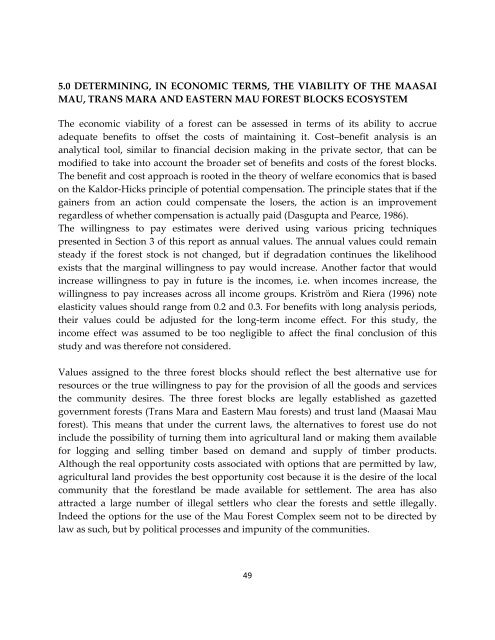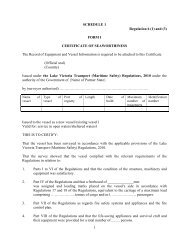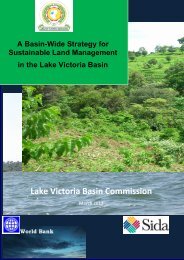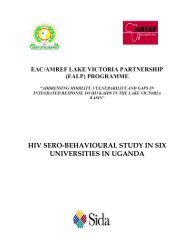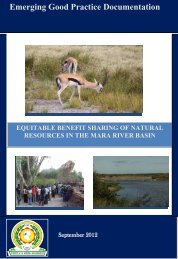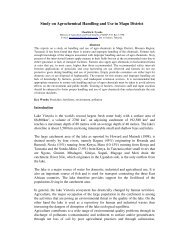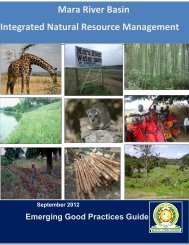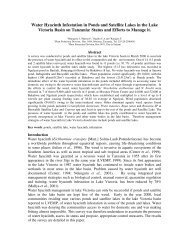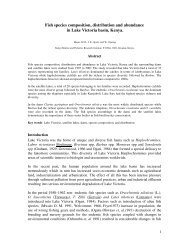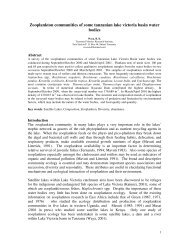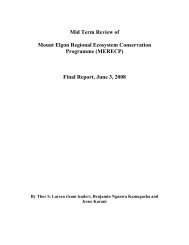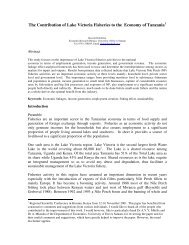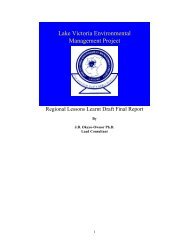Total Economic Value of Maasai Mau, Trans Mara and Eastern Mau ...
Total Economic Value of Maasai Mau, Trans Mara and Eastern Mau ...
Total Economic Value of Maasai Mau, Trans Mara and Eastern Mau ...
You also want an ePaper? Increase the reach of your titles
YUMPU automatically turns print PDFs into web optimized ePapers that Google loves.
5.0 DETERMINING, IN ECONOMIC TERMS, THE VIABILITY OF THE MAASAIMAU, TRANS MARA AND EASTERN MAU FOREST BLOCKS ECOSYSTEMThe economic viability <strong>of</strong> a forest can be assessed in terms <strong>of</strong> its ability to accrueadequate benefits to <strong>of</strong>fset the costs <strong>of</strong> maintaining it. Cost–benefit analysis is ananalytical tool, similar to financial decision making in the private sector, that can bemodified to take into account the broader set <strong>of</strong> benefits <strong>and</strong> costs <strong>of</strong> the forest blocks.The benefit <strong>and</strong> cost approach is rooted in the theory <strong>of</strong> welfare economics that is basedon the Kaldor-Hicks principle <strong>of</strong> potential compensation. The principle states that if thegainers from an action could compensate the losers, the action is an improvementregardless <strong>of</strong> whether compensation is actually paid (Dasgupta <strong>and</strong> Pearce, 1986).The willingness to pay estimates were derived using various pricing techniquespresented in Section 3 <strong>of</strong> this report as annual values. The annual values could remainsteady if the forest stock is not changed, but if degradation continues the likelihoodexists that the marginal willingness to pay would increase. Another factor that wouldincrease willingness to pay in future is the incomes, i.e. when incomes increase, thewillingness to pay increases across all income groups. Kriström <strong>and</strong> Riera (1996) noteelasticity values should range from 0.2 <strong>and</strong> 0.3. For benefits with long analysis periods,their values could be adjusted for the long-term income effect. For this study, theincome effect was assumed to be too negligible to affect the final conclusion <strong>of</strong> thisstudy <strong>and</strong> was therefore not considered.<strong>Value</strong>s assigned to the three forest blocks should reflect the best alternative use forresources or the true willingness to pay for the provision <strong>of</strong> all the goods <strong>and</strong> servicesthe community desires. The three forest blocks are legally established as gazettedgovernment forests (<strong>Trans</strong> <strong>Mara</strong> <strong>and</strong> <strong>Eastern</strong> <strong>Mau</strong> forests) <strong>and</strong> trust l<strong>and</strong> (<strong>Maasai</strong> <strong>Mau</strong>forest). This means that under the current laws, the alternatives to forest use do notinclude the possibility <strong>of</strong> turning them into agricultural l<strong>and</strong> or making them availablefor logging <strong>and</strong> selling timber based on dem<strong>and</strong> <strong>and</strong> supply <strong>of</strong> timber products.Although the real opportunity costs associated with options that are permitted by law,agricultural l<strong>and</strong> provides the best opportunity cost because it is the desire <strong>of</strong> the localcommunity that the forestl<strong>and</strong> be made available for settlement. The area has alsoattracted a large number <strong>of</strong> illegal settlers who clear the forests <strong>and</strong> settle illegally.Indeed the options for the use <strong>of</strong> the <strong>Mau</strong> Forest Complex seem not to be directed bylaw as such, but by political processes <strong>and</strong> impunity <strong>of</strong> the communities.49


